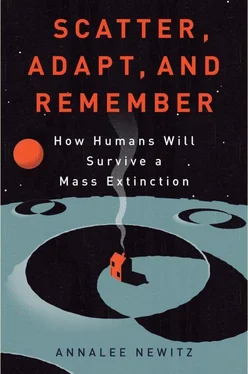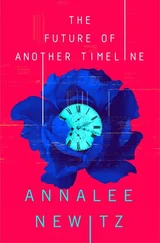What’s important is that the move into space sets humans on a journey that’s survivable. And it’s one that might yield many incredible discoveries along the way. Jemison, who told me she’s a fan of Octavia Butler’s writing, emphasized that she hopes the 100 Year Starship project will help humanity grapple with social as well as scientific issues. “What does it mean to be an interstellar civilization?” she asked. “What are the philosophical implications?” When I pushed her to answer those questions, however, Jemison did something very unexpected. She refused to speculate.
“The reason why is that if I speculate now, I can’t keep a blank whiteboard in front of me,” she explained. “As a person who is leading this, I don’t want to say, ‘When we get there it has to be this way.’ It may be totally different from what we expect.” By keeping her whiteboard blank, as it were, Jemison provides a model for what it means to plan for the future without foreclosing any possibilities. We can create maps and guides without locking ourselves into any particular outcome. The journey to the stars may take many forms. It may take centuries. But while we’re waiting and researching and designing our starships, we can build a civilization that’s sustainable back on Earth.
What Will They Remember About Us?
As we start our journey into the next million years, it’s useful to ask what you hope your progeny will remember about Homo sapiens . What do you want it to mean when they call themselves “human”? When I think about my post– Homo sapiens offspring, frolicking with their robot bodies in the lakes of Titan, I hope they remember us as brave creatures who never stopped exploring. What unites humans of the distant past with our possible future kin is an ability to survive adverse conditions by splitting into distant but connected bands. And what makes us human is our ability to build homes and communities almost anywhere. We should treasure this skill, because it is the cornerstone of our best survival strategy. We’ll strike out into space the way our ancestors once struck out for the world beyond Africa. And eventually we’ll evolve into beings suited to our new habitats among the stars.
Things are going to get weird. There may be horrific disasters, and many lives will be lost. But don’t worry. As long as we keep exploring, humanity is going to survive.
One of the most amazing parts of writing this book was getting a chance to discuss the future of humanity with so many scientists, engineers, philosophers, historians, technicians, and sundry brainiacs. That over a hundred people would take the time to share their ideas with a stranger, about everything from geological history to space exploration, is testimony to the basic awesomeness of humanity.
Thanks to my fantastic agent, Laurie Fox, for making all of this happen, and to my benevolent editor, Gerald Howard. Thanks to Hannah Wood for tons of editorial help, and to artist Neil Webb (who created the gorgeous cover).
I could not have written this book if my boss, Nick Denton, hadn’t given me the time to do it—thanks, Nick! And thanks to the io9 crew for always inspiring me: Charlie Jane Anders, Cyriaque Lamar, Esther Inglis-Arkell, George Dvorsky, Lauren Davis, Meredith Woerner, Robbie Gonzalez, Rob Bricken, and Steph Fox.
Thanks to members of the unnamed writing group: Claire Light, Sacha Arnold, Nicole Gluckstern, Lee Konstantinou, and Naamen Tilahun.
Many friends and strangers read early versions of the manuscript and gave me feedback: Deb Chachra, Tom Levinson, Maggie Koerth-Baker, Ed Yong, Terry Johnson, Dave Goldberg, Matthew Clapham, Peter Eckersley, and Daniel Rokhsar. None of the factual errors in this book are their doing.
Most important, thanks to three wonderful hominins, Charlie, Chris, and Jesse, who put up with all kinds of nonsense while I was writing this book, and whose love makes me the luckiest person in this limb of the galaxy.
INTRODUCTION: ARE WE ALL GOING TO DIE?
1. 30 percent of bee colonies: See U.S. Department of Agriculture, “Colony Collapse Disorder Progress Report” (2011), in which the Colony Collapse Disorder Steering Committee reports, “Annual surveys clearly show that overall colony losses continue to be as high as 30 percent or more since CCD began to be reported,” http://www.ars.usda.gov/is/br/ccd/ccdprogressreport2011.pdf.
2. amphibian crisis: D. B. Wake and V. T. Vredenburg, “Are We in the Midst of the Sixth Mass Extinction? A View from the World of Amphibians,” Proceedings of the National Academy of Sciences 105 (2008): 11466–73.
3. E. O. Wilson estimates that 27,000 species of all kinds go extinct per year: I should note that Wilson’s estimate has been extremely controversial in the conservationist community, with some scientists strongly disagreeing with the way he reached this number. Still, most biologists who disagree with the size of the number do not disagree with the notion that we are seeing a rise in extinctions. The estimate comes from E. O. Wilson, The Diversity of Life (Cambridge, MA: Belknap Press, 1992).
4. coined in the 1990s by the paleontologist Richard Leakey: See Richard Leakey, The Sixth Extinction: Patterns of Life and the Future of Humankind (New York: Anchor Press, 1996).
5. Elizabeth Kolbert has tirelessly reported on scientific evidence: Elizabeth Kolbert, “The Sixth Extinction?” The New Yorker (May 25, 2009): 53.
6. when you meet Earth scientist Mike Benton: Personal interview, November 2010. Previously quoted in my article “How to Survive a Mass Extinction,” io9.com(Nov. 29, 2010), http://io9.com/5700371/how-to-survive-a-mass-extinction.
CHAPTER ONE: THE APOCALYPSE THAT BROUGHT US TO LIFE
1. Earth is roughly 4.5 billion years old: For a more detailed account of the origins of life on Earth that I summarize here, see Andrew H. Knoll, Life on a Young Planet: The First Three Billion Years of Evolution on Earth (Princeton, NJ: Princeton University Press, 2003), and Jan Zalasiewicz, The Planet in a Pebble: A Journey into Earth’s Deep History (Oxford: Oxford University Press, 2010).
2. and Roger Summons is one of them: Personal interview, August 22, 2011.
3. asked his student Dawn Sumner: P. F. Hoffman and D. P. Schrag, “The Snowball Earth Hypothesis,” Terra Nova, vol. 14, no. 3 (2002): 129–55.
4. I visited Kirschvink at the California Institute of Technology: Personal interview, October 11, 2011. You can read Kirschvink’s groundbreaking paper on Snowball Earth, “Late Proterozoic Low-Latitude Global Glaciation: The Snowball Earth,” in J. W. Schopf and C. Klein, eds., The Proterozoic Biosphere: A Multidisciplinary Study (New York: Cambridge University Press, 1992). It’s also available online here: http://www.gps.caltech.edu/users/jkirschvink/pdfs/firstsnowball.pdf.
5. Bill McKibben, who argues in his book Eaarth: Bill McKibben, Eaarth: Making Life on a Tough New Planet (New York: Times Books, 2010).
6. In a remarkable paper published in Nature: Anthony Barnosky et al., “Has the Earth’s Sixth Mass Extinction Already Arrived?” Nature 471 (March 3, 2011): 51–57.
7. The statistician and paleontologist Charles Marshall: Personal interview, October 18, 2011.
CHAPTER TWO: TWO WAYS TO GO EXTINCT
1. Peter M. Sheehan, a geologist with the Milwaukee Public Museum: Peter M. Sheehan et al., “Understanding the Great Ordovician Biodiversification Event (GOBE): Influences of Paleogeography, Paleoclimate, or Paleoecology?” GSA Today , v. 19, no. 4/5 (April/May 2009).
Читать дальше






![Аннали Ньюиц - Автономность [litres]](/books/424681/annali-nyuic-avtonomnost-litres-thumb.webp)





